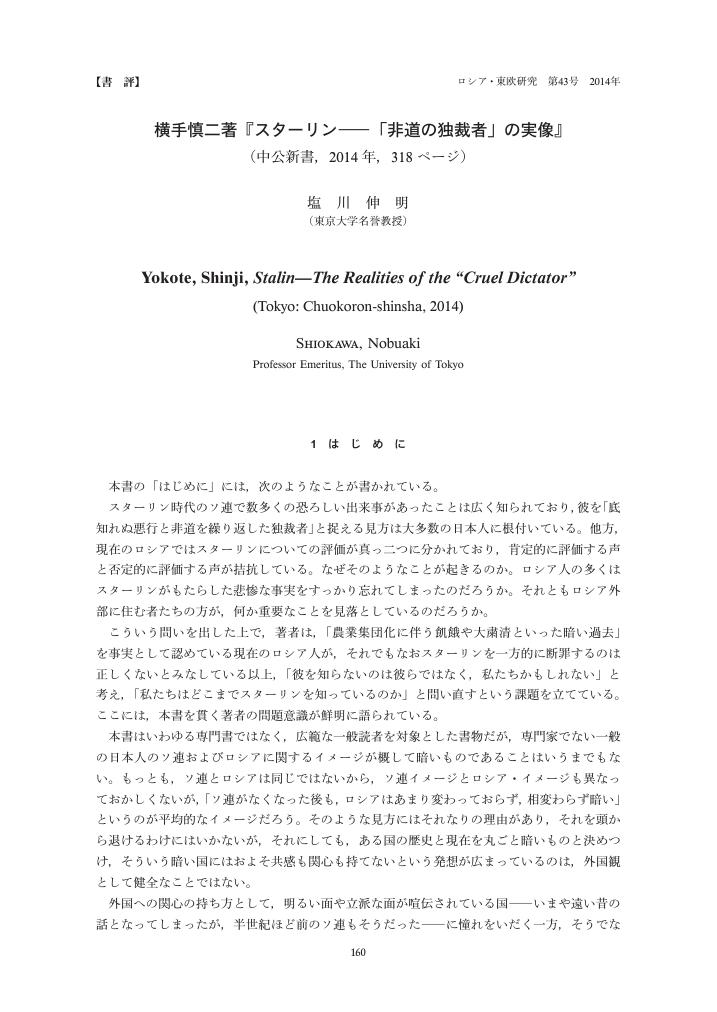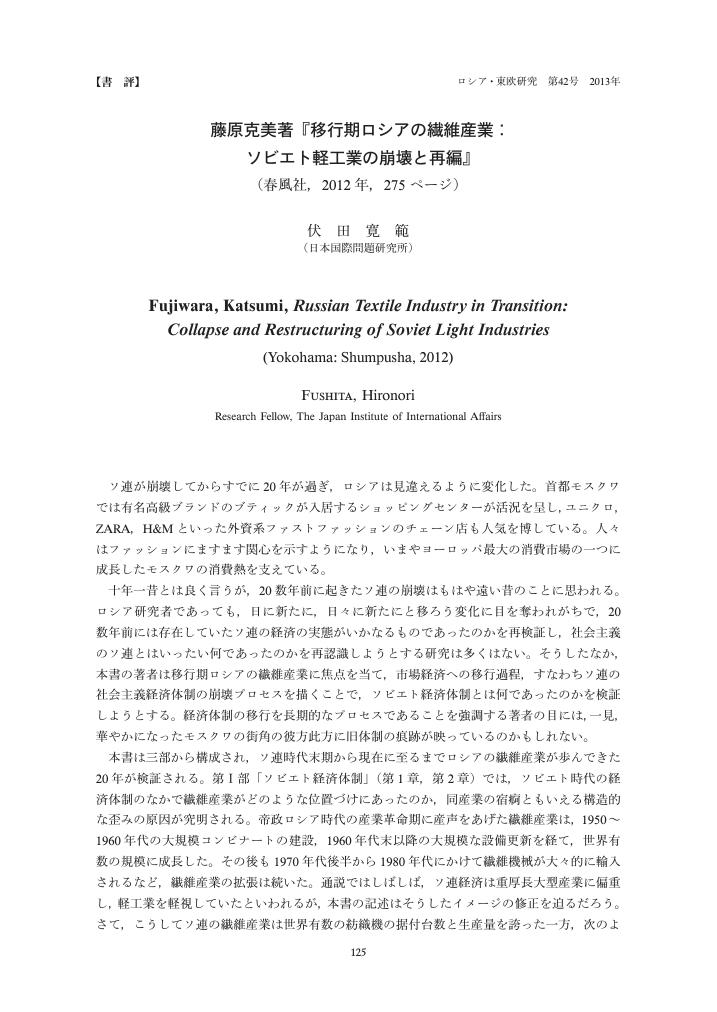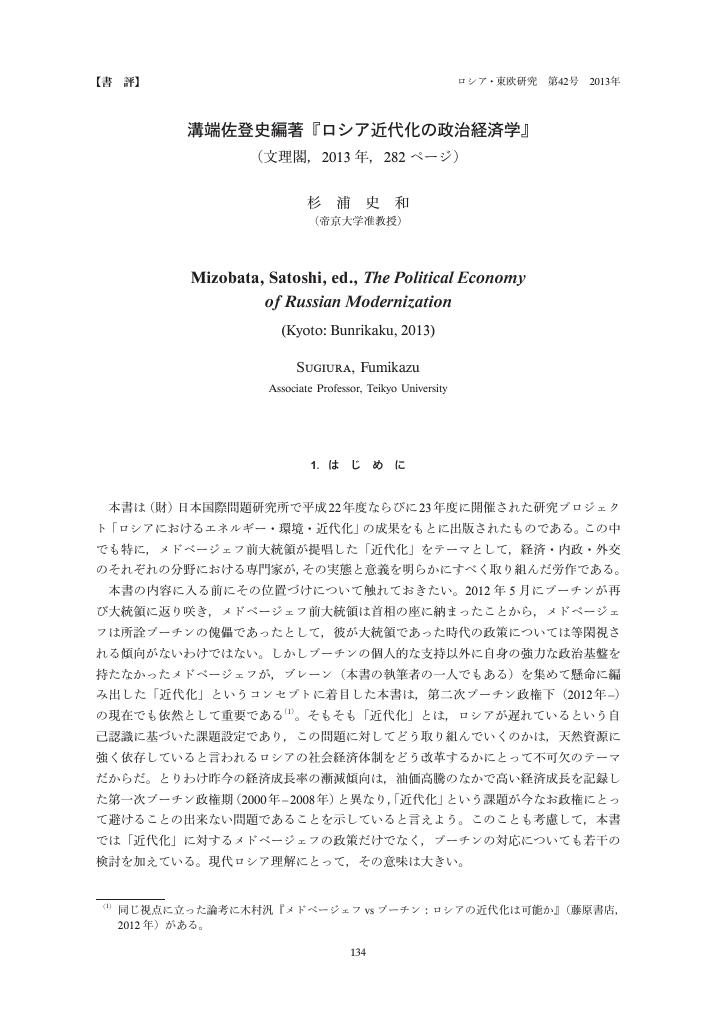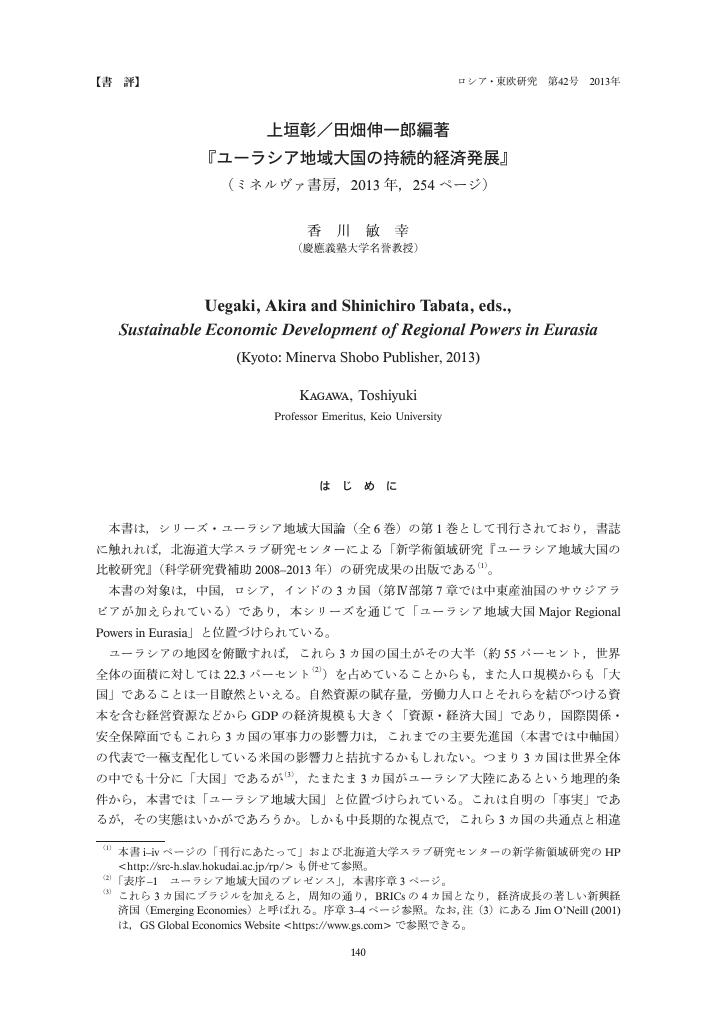- 著者
- 湯浅 剛
- 出版者
- ロシア・東欧学会
- 雑誌
- ロシア・東欧研究 (ISSN:13486497)
- 巻号頁・発行日
- vol.2014, no.43, pp.173-175, 2014 (Released:2016-09-09)
- 参考文献数
- 1
1 0 0 0 OA デイヴィド・シンメルペンニンク=ファン=デル=オイエ著(浜由樹子訳)『ロシアのオリエンタリズム―ロシアのアジア・イメージ,ピョートル大帝から亡命者まで』 (成文社,2013年,350ページ)
- 著者
- 黒岩 幸子
- 出版者
- ロシア・東欧学会
- 雑誌
- ロシア・東欧研究 (ISSN:13486497)
- 巻号頁・発行日
- vol.2014, no.43, pp.176-179, 2014 (Released:2016-09-09)
- 著者
- 大津 定美
- 出版者
- ロシア・東欧学会
- 雑誌
- ロシア・東欧研究 (ISSN:13486497)
- 巻号頁・発行日
- vol.2014, no.43, pp.180-184, 2014 (Released:2016-09-09)
- 参考文献数
- 6
- 著者
- 山添 博史
- 出版者
- ロシア・東欧学会
- 雑誌
- ロシア・東欧研究 (ISSN:13486497)
- 巻号頁・発行日
- vol.2014, no.43, pp.185-187, 2014 (Released:2016-09-09)
1 0 0 0 OA 存在感のあるロシア・東欧学会をめざして
- 著者
- 溝端 佐登史
- 出版者
- ロシア・東欧学会
- 雑誌
- ロシア・東欧研究 (ISSN:13486497)
- 巻号頁・発行日
- vol.2015, no.44, pp.1-3, 2015 (Released:2017-08-18)
- 著者
- 羽場 久美子
- 出版者
- ロシア・東欧学会
- 雑誌
- ロシア・東欧研究 (ISSN:13486497)
- 巻号頁・発行日
- vol.2015, no.44, pp.4, 2015 (Released:2017-08-18)
1 0 0 0 OA ロシアにおける石油随伴ガス処理問題 ―アクター,政策,制度分析からの接近―
- 著者
- 山脇 大
- 出版者
- ロシア・東欧学会
- 雑誌
- ロシア・東欧研究 (ISSN:13486497)
- 巻号頁・発行日
- vol.2014, no.43, pp.89-104, 2014 (Released:2016-09-09)
- 参考文献数
- 24
Regulations on the flaring and utilisation of associated petroleum gas (APG) have been in place since the early 1980s. Their purpose is environmental conservation and the effective use of limited natural resources. The formation on international frameworks, such as the World Bank’s Global Gas Flaring Reduction, which was launched in the 2000s, and the raising of environmental awareness in emerging and developing countries have also decreased the amount of APG flaring around the world. In Russia, however, the situation on APG utilization and flaring is entirely different. Here, the utilisation of APG has not improved since the 1990s. Even now, Russia remains the world’s largest APG-flaring country. This means that it is now explicitly confronted with problems on APG flaring and utilisation, while it struggles to adapt to global environmental protection trends and to modernise its economy. President Putin regards this problem as one of Russia’s most urgent tasks. On the 26 April 2007, at the Presidential Address to the Federal Assembly, he ordered his government to design solutions to achieve a more than 95% effective APG-usage level (less than 5 % flaring). In addition, the 7th government decision was selected, a policy that can enforce a fine for flaring over 5% of all APG and also for the use of infrastructure in oil fields that does not meet standards of approval. Nevertheless, the effectiveness of this fine policy remains limited. This situation suggests that the APG-flaring-and-utilisation problem in Russia has its own specificity and that it should not only be analysed from the current situation, but from the perspective of the continuity or incoherence of the Soviet Union actors, policies and institutions surrounding it, during this country’s transition to a market economy. As mentioned above, the APG utilisation and flaring in Russia is one of the most urgent environmental and economic problems among this country’s hydrocarbon industries. This study attempts to give some explanation on this situation. First, it analyses long-term APG-utilisation trends in Russia. Then, actors, policies and institutions involved in Russia’s APG utilization and flaring are traced. Finally, through the above-mentioned analysis, this paper tries to explain the situation and factors of Russia currently being the largest flaring country. JEL classification codes: L71, P28, Q35, Q40
1 0 0 0 OA 横手慎二著『スターリン―「非道の独裁者」の実像』 (中公新書,2014年,318ページ)
- 著者
- 塩川 伸明
- 出版者
- ロシア・東欧学会
- 雑誌
- ロシア・東欧研究 (ISSN:13486497)
- 巻号頁・発行日
- vol.2014, no.43, pp.160-165, 2014 (Released:2016-09-09)
- 著者
- ヨコタ村上 孝之
- 出版者
- ロシア・東欧学会
- 雑誌
- ロシア・東欧研究 (ISSN:13486497)
- 巻号頁・発行日
- vol.2014, no.43, pp.166-168, 2014 (Released:2016-09-09)
1 0 0 0 OA ソ連崩壊以降におけるロシアの畜産業の変化と穀物輸出余力への影響
- 著者
- 長友 謙治
- 出版者
- ロシア・東欧学会
- 雑誌
- ロシア・東欧研究 (ISSN:13486497)
- 巻号頁・発行日
- vol.2014, no.43, pp.135-152, 2014 (Released:2016-09-09)
- 参考文献数
- 30
The USSR was one of the main grain importing countries, because their grain production was insufficient for domestic consumption, including livestock feeding. After the collapse of the USSR, Russia’s agricultural production was dramatically curtailed through the 1990s, but in the 2000s, Russia returned to the international grain market as an emerging and one of the main wheat exporting countries. The primary reason for Russia’s transformation from a grain importing to a grain exporting country was its dramatic decrease in feed grain consumption in the 1990s, which was caused by reduced livestock production and the recovery of grain production in the 2000s. Russia’s livestock production recovered substantially in the latter half of the 2000s, but the increase in Russia’s feed grain consumption has been relatively small. It seems meaningful to analyze this phenomenon and to anticipate, to what extent further recovery of Russia’s livestock production will influence its feed grain consumption and grain exporting capacity. This paper attempts this analysis by examining concentrate feed consumption (mostly of grain) in Russian agricultural enterprises by types of livestock products (beef, pork, milk, etc.) and the contribution of two factors (“quantity of livestock production” and “concentrated feed conversion ratio”) to changes in concentrate feed consumption. The results of this analysis reveal two main reasons for the relatively small increase in feed grain consumption after Russia’s livestock production recovery. First, continued stagnating production prevented significant increase in feed consumption in the bovine sector (beef and milk production). Second, the declining concentrated feed conversion ratio curbed the increase of concentrated feed consumption in the poultry and pig sectors. Increasing livestock production in Russia would cause increased feed grain consumption and contribute to a decline in grain export capacity to some extent. However, considering the above-mentioned changes in Russia’s livestock industry, Russia’s reversion to a grain importing country seems unrealistic.
1 0 0 0 OA 宮川絹代著『ブーニンの「眼」―イメージの文学』 (水声社,2013年,428ページ)
- 著者
- 木村 崇
- 出版者
- ロシア・東欧学会
- 雑誌
- ロシア・東欧研究 (ISSN:13486497)
- 巻号頁・発行日
- vol.2014, no.43, pp.153-155, 2014 (Released:2016-09-09)
- 著者
- 伊東 孝之
- 出版者
- ロシア・東欧学会
- 雑誌
- ロシア・東欧研究 (ISSN:13486497)
- 巻号頁・発行日
- vol.2013, no.42, pp.121-124, 2013 (Released:2015-05-28)
- 著者
- 伏田 寛範
- 出版者
- ロシア・東欧学会
- 雑誌
- ロシア・東欧研究 (ISSN:13486497)
- 巻号頁・発行日
- vol.2013, no.42, pp.125-127, 2013 (Released:2015-05-28)
- 著者
- 角田 安正
- 出版者
- ロシア・東欧学会
- 雑誌
- ロシア・東欧研究 (ISSN:13486497)
- 巻号頁・発行日
- vol.2013, no.42, pp.131-133, 2013 (Released:2015-05-28)
1 0 0 0 OA 溝端佐登史編著『ロシア近代化の政治経済学』 (文理閣,2013年,282ページ)
- 著者
- 杉浦 史和
- 出版者
- ロシア・東欧学会
- 雑誌
- ロシア・東欧研究 (ISSN:13486497)
- 巻号頁・発行日
- vol.2013, no.42, pp.134-139, 2013 (Released:2015-05-28)
- 著者
- 香川 敏幸
- 出版者
- ロシア・東欧学会
- 雑誌
- ロシア・東欧研究 (ISSN:13486497)
- 巻号頁・発行日
- vol.2013, no.42, pp.140-144, 2013 (Released:2015-05-28)
- 著者
- 羽場 久美子
- 出版者
- ロシア・東欧学会
- 雑誌
- ロシア・東欧研究 (ISSN:13486497)
- 巻号頁・発行日
- vol.2013, no.42, pp.2, 2013 (Released:2015-05-28)
1 0 0 0 OA 境界を描く ―ボスニア出身作家たちの作品に見るボスニア像―
- 著者
- 三谷 惠子
- 出版者
- ロシア・東欧学会
- 雑誌
- ロシア・東欧研究 (ISSN:13486497)
- 巻号頁・発行日
- vol.2013, no.42, pp.17-31, 2013 (Released:2015-05-28)
- 参考文献数
- 36
As a cultural space, Bosnia was formed on the borders of Western and Eastern Christianity, Islam, and Judaism. Religious diversity in the heartland of the Balkans did not cause serious conflict, but rather fostered coexistence, until the end of the Ottoman regime. However, the nationalism that emerged in surrounding areas during the nineteenth century penetrated Bosnia, where the question of national belongings became increasingly pressing in the twentieth century. The collapse of Yugoslavia under the slogan of the “brotherhood and unity” was followed by war; multiethnic Bosnia disintegrated into three ethnic components, those of the Bosniaks, Croats, and Serbs, and two political entities, the Federation of Bosnia and Herzegovina, and the Republika Srpska. This paper deals with the representation of Bosnia in the literary works of native Bosnian writers; it focuses on the polysemic feature of “the border” and reveals that the diverse portrayal of Bosnia in these works reflects each writer’s experience and the more general social situation. In his short story, “Letter from the Year 1920,” Ivo Andrić presents Bosnia as “a land of hatred” and profiles its religious diversity as generating intercultural conflicts. The depiction of Bosnia as demarked by multiple cultural borders is characteristic of Andric’s compositions; this short story reveals a striking picture of such a Bosnia, one that echoes the writer’s experience in the two disastrous wars of the first half of the twentieth century. Hasan, a character in Meša Selimović’s novel The Dervish and Death, which was published in 1966, describes the Bosnian as an in-between, unfinished creature, deprived of any particular cultural identity. In this depiction, Hasan discloses the internal state of Selimović, an atheistic communist who values traditional Muslim culture. At the same time, the Bosnian depicted by Hasan reflects the condition of the Muslims of Yugoslavia until the end of 1960s, when they remained a vague ethnic group without any official nationality. Andrićʼs character Maks Levenfeld, who depicts Bosnia as a land of hatred, reappears in Dževad Karahasan’s “Letter from the Year 1993,” first published in 1996. In contrast to Andrićʼs Maks, Karahasan’s character describes Bosnia as a multicultural space in which people “jealously” maintain their cultural diversity. Bosnia here is conceptualized as a domain of intercultural communication, and the borders once featured by Andrić as dividing lines are profiled as interstitial spheres that create a society with internal cultural diversity. By reversing the picture represented in the letter of Andrićʼs Maks, Karahasan tries to recover his Bosnia, whose society is balanced by cultural diversity. The different presentations of Bosnia in three writers correspond to diverse conceptualizations of “the border”—Andrićʼs as dividing lines; Selimovićʼs as in-between places where people without clear identification dwell; and Karahasanʼs as interstitial spaces that can generate intercultural relationships. Each also reflects a different phase in the history of Bosnia, from the time immediately after World War II, through the Yugoslav regime, to the collapse of the multinational state.
1 0 0 0 OA ロシアにおける中国人理解 ―メタファーとしてのディアスポラ―
- 著者
- 堀江 典生
- 出版者
- ロシア・東欧学会
- 雑誌
- ロシア・東欧研究 (ISSN:13486497)
- 巻号頁・発行日
- vol.2013, no.42, pp.32-44, 2013 (Released:2015-05-28)
- 参考文献数
- 39
This paper investigates “Chinese diaspora,” the term used by the Russian media and in Russian scholarly articles to describe the Chinese residing and working in Russia either permanently or temporarily. Although Russia’s perceived threat of Chinese migration to Russia has calmed as compared to the 1990s, Russian citizens are still intolerant of Chinese inclusion into Russian society and the apparent unwillingness of the Chinese to adapt. Hostility against the Chinese can be avoided by understanding their activity in Russia, as well as the roots of Russian society’s stereotyping of the Chinese. This paper focuses on the term Chinese diaspora because it has not previously been theoretically considered. In addition, whether this Chinese presence in Russia qualifies as actual diaspora has not been thoroughly examined, despite its wide use to describe the Chinese currently residing and working in Russia. The aim of this paper is to examine how the term Chinese diaspora as a metaphor operates in Russian society, as well as how the boundary between Russian citizens and the Chinese has been maintained not by diasporic motivation, but by Russian motivation to perpetuate it. This paper first examines how the term Chinese diaspora is used by the Russian media and in Russian scholarly articles, and then describes how this usage differs from the definition of diaspora in the theoretical sense and from how the Oversea Chinese worldwide define themselves as diaspora. This paper also examines the diasporic ties between Chinese migrants and their home countries and diasporic practices from a historical perspective. Chinese diaspora should be analyzed by the diasporic stances, projects, claims, idioms, practices, and so on, that are motivated from the diaspora side, even if they passively accept or adapt their diasporic stances. This analysis finds that there is no diasporic cohesion between new and old Chinese immigrants to Russia in term of their origins, and no consistent and well-organized diasporic practice. This paper’s investigation makes it clear that the Chinese diaspora in Russia does not presently exist from the perspective of diasporic theory and social practices. The term Chinese diaspora is a metaphor designed by Russia to maintain the boundary between Russian society and Chinese migrants. The grouping of Russia’s Chinese population into this putative diaspora keeps them arbitrarily bounded by the host society. With this grouping, biased views against Chinese immigrants remains as a device to instigate new threats against them or inflate existing threats, even if those who speak about the Chinese immigrants welcome them or not. The term Chinese diaspora in the Russian context should be used carefully. Its use hinders the Chinese by stereotyping them as a putative diaspora, provoking an inexplicable disquiet among the host citizens that keeps them intolerant of Chinese immigrants.















